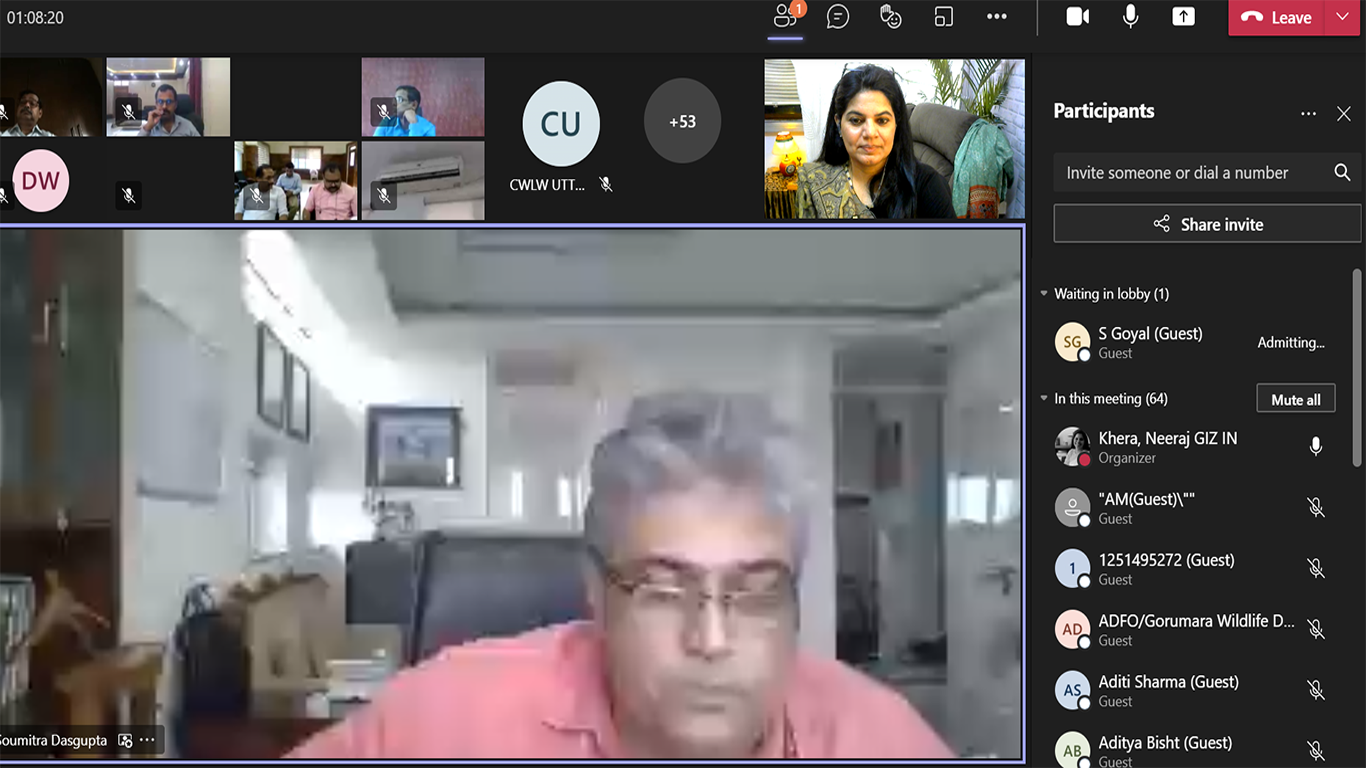01 Jul, 2021
GIZ India, Ministry of Environment, Forest and Climate Change (MoEFCC) and State Forest Departments (SFD) of Karnataka, Uttarakhand and West Bengal organised an online workshop under the Indo-German project on “Human-Wildlife Conflict Mitigation (HWC)” in India on 1 July 2021. The workshop commenced the process of pilot implementation of species-specific guidelines on human-wildlife conflict mitigation in India.
Ten species-specific and four issue-specific guidelines are being developed under the Indo-German project and will be implemented using a harmonious co-existence approach, to ensure that the mitigation measures are both effective and wildlife-friendly. The current drafts are the result of over two years of participatory processes, where a group of more than 80 experts including scientists, practitioners, decision-makers, field response teams, capacity development and strategic experts contributed to its development. Before the guidelines are finalised, the draft guidelines will be pilot tested in 20 forest divisions and selected protected areas (PA) in India. The report on the feasibility and acceptability of the recommendations will be expressed in the draft guidelines, using structured processes and tools.
The workshop on 1 July was organised to bring together the nodal officers from the 20 piloting divisions, PAs, authors of the guidelines, and key officials and experts from MoEFCC, SFDs, GIZ, WII, and National Technical Group (NTG). The workshop aimed to develop a common understanding of the current situation in 20 divisions and key recommendations from the guidelines, apart from fine-tuning the operational details of the piloting process.
The workshop commenced with the opening address by Mr Rohit Tiwari, Inspector General of Forests (Wildlife), MoEFCC, followed by a setting of the context by Dr Neeraj Khera, Team Leader, Indo-German HWC Mitigation project. She provided the overview of the pilot implementation process, methods and approach.
Special remarks from Mr J. S. Suhag, PCCF (WL) and Chief Wildlife Warden, Uttarakhand, Mr V. K. Yadav, PCCF (WL) and Chief Wildlife Warden, West Bengal, and Mr S. K. Malkhede, APCCF (WL), Karnataka emphasised on the relevance of the guidelines to address the HWC situation in the States. They appreciated the efforts being made to pilot test the guidelines with a participatory approach. Dr Dhananjay Mohan, Director, WII, highlighted the need for pilot testing and encouraged all field officers to provide their feedback on the guidelines. Special address from Mr Soumitra Dasgupta, Additional Director General – Wildlife, MoEFCC emphasised the need to intensify efforts to ensure that the pilot testing of guidelines is completed by the agreed timelines. He also stressed that the finalised documents should be of high-quality, user-friendly translation to local languages for effective usage at the field level.
A detailed session to discuss the current HWC situation and mitigation measures in the 20 piloting divisions was structured to receive inputs on the landscape level situation from the senior officials from the State Forest Department, including Mr S.K. Malkhede on Kodagu and adjoining landscapes, and Mr Rajendra Jakher, Chief Conservator of Forest Wildlife North, West Bengal on North Bengal Landscape.
Division-wise situation and current mitigation measures were shared by the Divisional Forest Officers of the following piloting divisions: Virajpet Division, Madikeri Division, Ramnagar Division, Hassan Division, Tumkur Division, Gadag Forest Division, Kopal Forest Division and Haveri Forest Division from Karnataka; Gorumara Division, Kurseong Forest Division, Buxa Tiger Reserve, Medinipur Division, Sunderban Tiger Reserve and Jalpaiguri Forest Division from West Bengal; and Haridwar Division, Rajaji Tiger Reserve, Bageshwar Division, Nandadevi National Park and Tehri Forest Division of Uttarakhand.
The situation analysis from the 20 divisions was followed by the experts and authors of the species-specific guidelines providing an overview of the guidelines including Dr K Siva Kumar for Human-Crocodile Conflict Mitigation, Dr S. Sathyakumar for Human-Bear Conflict Mitigation Guidelines, Dr Aditi Sharma for Human-Leopard Conflict Mitigation Guidelines, Dr Ramesh Chinnaswamy for Human-Snake Conflict Mitigation Guidelines, Dr Qamar Qureshi for Human-Macaque Conflict Mitigation Guidelines and Human-Wild Boar Conflict Mitigation Guidelines, Dr Sanath K Muliya on Occupational Health and Safety Guidelines and Mr P. C. Tyagi on Human-Gaur Conflict Mitigation Guidelines. Mr Tyagi also provided valuable guidance to the division officers on the pilot implementation process. Participants were introduced to the two experts engaged by GIZ to facilitate the process of baseline development and documentation on the pilot testing process: Mr Surendra Varma – ANCF and Dr Jaiyati Rawat.
The workshop ended with closing remarks by Mr Sunil Sharma, Joint Director (Wildlife), MoEFCC. He applauded the effort invested by GIZ and experts in developing the guidelines and expressed his expectation of a well-structured pilot implementation process.
The workshop had 65 participants from MoEFCC, GIZ, WII, SFDs of Karnataka, West Bengal and Uttarakhand, senior decision-makers wildlife experts, veterinary and one health experts, and documentation experts.
.png)
.png)


*
The Human-Wildlife Conflict Mitigation (HWC) project is implemented by the Deutsche Gesellschaft für Internationale Zusammenarbeit (GIZ) GmbH on behalf of the German Federal Ministry for Economic Cooperation and Development (BMZ) in partnership with the Ministry of Environment, Forest and Climate Change, and State Forest Departments of Karnataka, Uttarakhand and West Bengal. The project aims at providing technical support at the national level, and effective implementation of HWC mitigation measures in selected states of India. The project pilot sites are Haridwar Forest Division and adjoining landscape including Rajaji Tiger Reserve in Uttarakhand, Gorumara Wildlife Division in West Bengal, and Kodagu Forest Circle in Karnataka.
The main objective of the project is that the rural population in project areas, where agreed guidelines and tools are applied to mitigate human-wildlife conflict, is better protected against it. The project takes the approach of harmonious coexistence, by ensuring that both—humans and wildlife—are protected from conflict. Read more
For more information contact: biodiv.india@giz.de
© 2014 IGBP. All Rights Reserved.
Site By: Virtualpages
